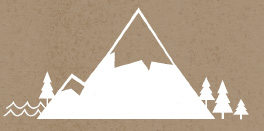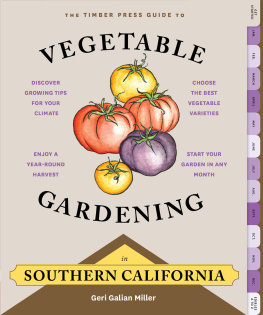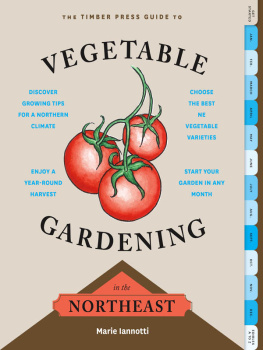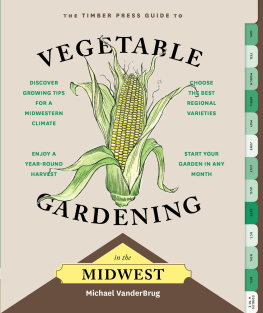THE TIMBER PRESS GUIDE TO VEGETABLE GARDENING
in the
PACIFIC NORTHWEST
LORENE EDWARDS FORKNER
Timber Press
_________________
Portland London
Copyright 2012 by Lorene Edwards Forkner.
All rights reserved.
Chapter opening illustrations by Kate Giambrone and Julianna Johnson
All other illustrations Julia Sadler
Published in 2012 by Timber Press, Inc.
The Haseltine Building
133 S.W. Second Avenue, Suite 450
Portland, Oregon 97204-3527
timberpress.com | 2 The Quadrant
135 Salusbury Road
London NW6 6RJ
timberpress.co.uk |
Book design by Kate Giambrone and Julianna Johnson
Library of Congress Cataloging-in-Publication Data
Forkner, Lorene Edwards.
The Timber Press guide to vegetable gardening in the Pacific Northwest / Lorene Edwards Forkner. --1st ed.
p. cm.
Guide to vegetable gardening, Pacific Northwest
Includes index.
ISBN 978-1-60469-572-4
1. Vegetable gardening--Northwest, Pacific. 2. Vegetables--Northwest, Pacific. I. Title. II. Title: Guide to vegetable gardening, Pacific Northwest.
SB321.5.N58F67 1013
635--dc23
2012021280
For Hilary and Max, my best crop
TABLE OF CONTENTS
Preface
Growing fruits and vegetables is a crazy good thing. I love it. From that chilly spring day when I bundle up and venture outside to briskly poke pea seeds into the wet soil to hot summer afternoons spent staking tomatoes, their sticky foliage enveloping me in a slightly bitter herbal aroma and staining my fingers oliveI find the entire process endlessly appealing. But all that pales next to the sheer pleasure of going into the backyard and harvesting crops in their prime. Its all about the food people!
Several years ago while driving along with NPR on the radio, I caught an interview with Greg Atkinson, Northwest chef extraordinaire, recounting a conversation hed had with esteemed food writer Ruth Reichl. Her assessment of our regions many resources struck me so strongly I immediately pulled to the curb to write it down. To paraphrase Reichl: the Pacific Northwest has a climate and a geography that makes human beings feel very welcome on the planet.
Indeed, ours is a land of plenty, ripe with potential. Ample rainfall (ahem), good soil, and moderate temperatures grant a long and hospitable growing season. But we grow things a little differently in the PNW (defined in this book as western Washington, western Oregon, and southern British Columbia). All gardening is local and especially so if you happen to reside in a region embraced by mountains, bordered by salt water, or run through by rivers. Cool-season crops (like kale, carrots, and cabbages) yield generously, demanding little from us aside from the care of the soil and attention. But if you want your harvest to also include tomatoes, eggplants, cucumbers, and peppers it pays to approach the growing season with a definite plan and a few simple tricks to maximize summer heat.
This book will take you through every month and the many eccentricities of the PNW gardening year. Youll find tips and techniques as well as suggestions of plants and specific varieties proven to excel in our region. No matter what youre looking to harvesta windowsill crop of midwinter microgreens, fresh salads spring through fall, a bumper crop of tomatoes, or a few savory herbs to enliven your dinnerthis is your guide to navigating the delicious possibilities available to the PNW grower. Read this book cover to cover on a rainy winter night for a complete crash course in edible gardening. Or pick it up midsummer to discover how to turn the seedlings you purchased on a whim at the farmers market into a tasty, healthy harvest. Growing good food means something different to each of us.
Whether youre new to growing or a seasoned green thumb, cultivating a year-round PNW garden is a continuing education as well as a nearly constant feast. Some years are more challenging or fruitful than others and sometimes the harshest seasons are the best teachers. Tellingly, a recent record cold spring divided backyard growers into two camps: anguished impatience as months slipped by unproductively between way-too-clean fingers; and resilient, philosophic acknowledgment that this sometimes happens. The latter group comforted, and fed, by overwintered and perennial crops producing in spite of irregular climatic circumstances.
Distracted by deadlines and a busy life, I found myself squarely among the anguished. But even though this years harvest has not been my best by a long shota cruel and humbling irony when days are spent writing and telling others how to succeedit was modestly offset by endless salad greens, mountains of kale, and the sweetest peas Ive ever picked. I plan to spend the winter rebuilding my soil, installing a sheltering windbreak, and putting up shop lights for a seed-starting area in the basement. Its time to shake off last year and anticipate the next. The new seed catalogs should start arriving any day and I cant wait.
Welcome to another year in the garden. Dig in!
Acknowledgments
Tending a PNW vegetable garden is a delicious dance with time and space. We choreograph the production of our backyard bounty while chasing the sun throughout the calendar, sidestepping pests, and adapting to the occasionally chill growing season. Writing a book has its own fancy footwork involving word count, fact checking, and clarity. Whether your final crop is a bowl of fragrant raspberries or a finished manuscript, youre going to need fertile conditions and warmth to succeed.
Bountiful thanks to those at Timber who cultivate and edit my words. My friends, gardening matters. I am so fortunate to have colleagues who share that conviction and provide the platform for me to tell others.
Friends and family tend my heart during the writing process and throughout our sometimes challenging growing season. They put up with deadlines and my innumerable rants about our fickle climate, bad bugs, and green tomatoes, and still help with the heavy lifting. Fresh salads, succulent tomatoes, juicy berries, and glowing moons of squash are capable of charming even the most reluctant into taking their turn at the end of the hose. In return, I feed them good food with love and gratitude.
And I cant help but give a shout out to local farmers and chefs who continue to provide and prepare fresh, local, seasonal food whether I get around to planting or not. The fact that they do so while also preserving the environment, building the soil, sustaining local varietiesand hopefully making a livingis yet another reason to give thanks for our remarkable PNW food culture. Plant a patch of ground or face a mountain of kale (or green tomatoes) and see if you dont look at these folks with newfound respect.
GET STARTED

OUR UNIQUE MARITIME CLIMATE

Yes, it rains a lotexcept for those months when it dries up altogether. Ours is a maritime climate greatly influenced by the largest body of water on the planet. Some things are simply beyond our control. Our mild winters and long springs are ideal for cultivating a variety of cool-season crops, many of which tolerate light frost. Summers, while warm, pleasant, and generally dry, rarely get hot enough to hinder plants that dont do well in heat. True, occasionally well struggle to ripen warm-season crops like tomatoes, peppers, eggplants, and corn, but well always have kale and other hardy crops that produce in fall and over winter. This short chapter offers a laymans overview of a maritime climate and introduces the notion of climate cues as they relate to garden planning.
Next page









